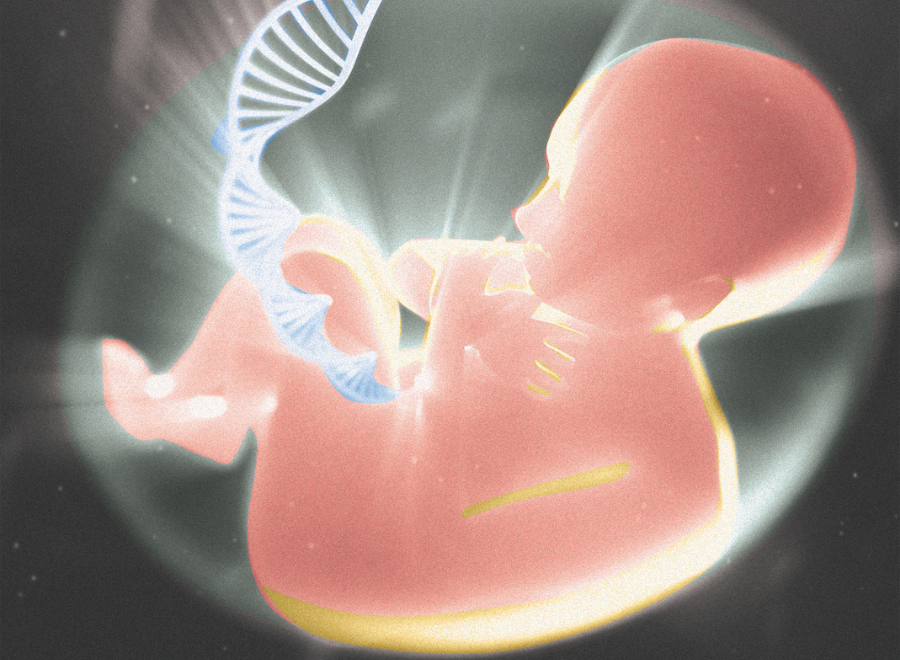At 9 a.m. on her 40th birthday, Kate Latour was already prepped for the abortion at the Stanton Territorial Hospital in Yellowknife. A doctor came into her room, she recalls, pushed a needle into her abdomen and ended her 22-week pregnancy. “Amelia,” an amniocentesis confirmed a week previously, had Down syndrome. It was Latour’s decision to terminate — and her husband’s.
Latour, tall and thin, a perfectly pale blend of her father’s Danish and mother’s Mennonite ancestry, considers herself spiritual but not religious. Apart from memories of church shopping as a child and what her parents passed on from their loose adherence to the Lutheran and United churches, she was unfettered by dogma in her decision-making. Not helped, either.
You may unsubscribe from any of our newsletters at any time.
For the few days in December 2010 between finding out that the baby had Down’s and deciding to terminate, she divined her path using the tools available to her: the Internet and conversation with her husband. It was a rational decision at the time, she recalls. But it’s not a decision they’d make again.
“People with Down syndrome don’t stay in Hay River,” Latour says of the small town in the Northwest Territories where she lives, explaining why they’d decided to abort. “If we stayed, I know what would have happened to her in school, and it wouldn’t be pretty. For us to get the services Amelia would need, we’d have had to leave everything: our house, our jobs, our families and friends. It would have been awful either way.”
Latour’s is among the first generations of women responsible for deciding the fate of their unborn based on prenatal genetic analysis. For four million years of human history, controlling what came out of your womb was in the realm of magic. Now, it’s clinical. And the vetting will only intensify as new tests become available. At the centre of the swirling genetics debate conducted by scientists and ethicists and theologians and doctors, young women stand alone. In Canada, the median age of a first birth is 28. These would-be mothers are the ones who must negotiate these decisions and what they mean for their families, the world and their individual spirits.
It’s not fair.
Since 1968, when fetal ultrasound began to be used, screening has been a blunt instrument: identify undesirable characteristics and (probably) terminate. Most provinces also offer the triple- or quad-screen blood test at about 12 weeks, which identifies markers for spina bifida, anencephaly, Down syndrome and Edwards syndrome.
On the cutting edge of testing, pre-implantation genetic diagnosis (PGD) now makes it possible to screen embryos before they’re implanted in a womb via in vitro fertilization (IVF). In the United States and other places, though not in Canada, embryos may be screened for gender, as well as the breast cancer gene, Tay-Sachs and other potential diseases. Those that test positive are disposed of.
Within 10 years, according to some scientists, women will be able to not only screen for disorders but select for a host of other characteristics, including perhaps athleticism, intellectual capacity and beauty. But when it comes to designing babies, what is moral? A world without disability, for example, may not be the utopia some presume.
Bioethicists are raging. So are some churches. The Vatican has outlawed abortions and IVF. Some evangelical leaders are promoting the “adoption,” or rescue and implantation, of discarded embryos, with the rationale that life begins at conception. In Vancouver, one Sikh activist is using rap and YouTube to fight gender abortions in Punjab. Meanwhile, most liberal Protestant churches have yet to make any public statements about adherents’ use of genetic technology.
The last time The United Church of Canada directly spoke out about this issue was in the 1977 Report of the Commission on Ethics and Genetics. The authors predicted some problems associated with genetic control: ugly choices, such as gender selection; the further exploitation of the poor; and messing with God’s plans. “With the advent of genetic manipulation God is calling man, here and now, to an increased responsibility,” the document states. “Whether it will reflect the shame or the glory of human achievements will be decided by the degree of wisdom and patience we bring to its application and use.”
Ultimately, the document does not embrace or reject the coming technology. Nor, interestingly, does it anticipate the spiritual and moral distress that often accompanies choice. As Latour discovered, where reproductive science meets personal spirituality in the 21st century, there’s no map. Does a fetus get a funeral? Can you share your grief? How do you explain the disappearance of the rounding belly to a community without a unified opinion on abortion and disability? Does a mother have the right to ache for a child she aborted — or even an embryo she deselected?
Winging it spiritually, the Latours cremated Amelia’s remains. Then, they sent some of the ashes to be pressurized into crystal. Latour literally wears Amelia around her neck — now in the shape of a light blue tear-drop gem — as a constant memorial. Her voice still breaks, talking about the child she never met, one year later.
Latour’s story raises a question: What should pro-choice denominations such as the United Church offer to young families to support them in their engagement with emerging reproductive technology?
For Ronald Green, the answer is empathy, not judgment. He has little patience for religions that try to shut down access to reproductive choice. As the dean of Dartmouth College’s Ethics Institute and a religious studies professor, he’s spent the past 20 years studying emerging technologies. In his 2007 book, Babies by Design: The Ethics of Genetic Choice, he argues that you can’t stop this stuff. Instead, he said, faith leaders should use their power to ensure genetic technology is delivered in ways that uphold social justice. Ensure fair access, in other words.
“It’s inevitable and unstoppable,” he says on the phone from Connecticut. “Whenever people have the power to control something about their fertility, they demand it. So you can’t just be oppositional. Understand the nuances; understand how we live our lives. Try to keep an open mind.”
He also advises that faith leaders and new parents grapple with the idea of progress. Genetic control, he says, may eliminate most gene-based diseases and disabilities within 100 years; cryogenic technology will give women the ability to delay childbearing into their 40s; choosing genetic attributes from a “menu” will allow parents to express their ideas about perfectionism in human form.
Will this make life better? Green doesn’t know.
“I support progress, adaptation, learning about this,” he says. “There will be new dilemmas, new hardships. Are women really that much better off than they were 100 years ago, when they had nine children and were confined to the home? I don’t know. But it’s impossible to be that woman now. People have to adapt and, always, presume the human in their circumstances.
It’s true.
Where choice and control exist, women want it. And they’re getting it without much discussion.
In Winnipeg, however, family doctor Larry Reynolds believes that genetic testing and the quest for control is undermining women’s authentic experiences of childbearing. He has been catching Prairie babies for more than 40 years. Over that time, he has witnessed the effects of prenatal screening on his patients in the rise of what he calls “the culture of perfection.” It manifests in his office, he says, though young pregnant women’s “insatiable appetite for information through testing.”
He worries that technologies that allow parents to design their children — the tests that exist now and those that are coming — are being delivered into a culture where rich conversation about the implications of such procedures does not happen.
“Women can be stampeded into decisions they’ll later regret,” he says. “What’s their feeling about children with disabilities? What is the role of people with disabilities in our culture? These conversations do not lend themselves to short doctor visits.”
Nor should they, Reynolds argues. Instead, he says, the culture of perfection and the future of disabilities should be challenged in public discourse, in public policy. They shouldn’t be foisted onto the shoulders of his young, often disadvantaged patients.
Erasing “imperfect” babies also takes a largely unrecognized toll on parents, Reynolds says. As an alternative, part of his work involves perinatal palliative care. For women carrying a severely disabled fetus that may only live a few hours — prime candidates for abortion — choosing to birth the child rather than abort can be a pivotal spiritual experience for some.
“It gives them a chance to say hello before they say goodbye,” he says. “It also lets other people have an experience of the child before death.”
This is the world Ann Heesters and Jim Huth inhabit at the Toronto Rehabilitation Institute (Toronto Rehab). Heesters heads up the clinical bioethics department, a specialty she created for herself at several hospitals across eastern and central Canada. Huth is a hospital chaplain with a PhD in bioethics. Together, they’re pioneering a joint department of spiritual care and bioethics — two different approaches to helping patients and their families make decisions about medical matters.
Many people, Heesters and Huth find, are forced into making decisions quickly, without processing their own values first. They aim to stop that. Huth knows these decisions take more than time. As a chaplain, he says, his job is to help take patients deep into themselves, to “drill down to where the messiness is” and be curious about it. Instead of pestering a patient for a decision, as medicine often does, he “loiters” in the messiness, helping patients to connect the unconnected part of themselves: their values, their stories, their relationships, their fears.
To Huth, the role of the church in the future of designing babies should be simple. Walk with the women who are forced to make these incredibly difficult decisions. “As Christian people, we journey with each other,” he says. “It defines who we are. It is primary. The question is, how do we take hold of the one who did what she thought she should and found that her spirit was broken? She gets broken in this. She gets ripped apart in this. Can the church be with them before the decision is made, in the decision, and after the decision in all this messiness?”
That’s an open question. And for those who are young, grappling with their ethics and needing to make a decision, church may not be the first place they turn for guidance. This is an age group that is least likely to be a part of a congregation, after all.
Whatever the future of technology holds, one thing is certain: Canada’s young women will increasingly walk a spiritual gauntlet during their childbearing years. How they manage it will often depend entirely on their own internal resources.
Since the abortion of Amelia, for example, Latour says she’s grown up “one hell of a lot.” She’s trying to get pregnant again, taking Clomid, seeing a naturopath. If she’s lucky enough to conceive and the fetus is again atypical, they won’t abort.
Life will be difficult with or without a daughter with Down syndrome, she has learned. But at least if they had kept the baby, they’d now have a baby, she says, instead of an ache and an absence.
***
TIMELINE OF GENETIC INTERVENTIONS
Early 20th century
Birth control campaigner Margaret Sanger, outraged by poor conditions in American inner cities, calls for the legalization of birth control — in part for eugenic reasons. “Greater understanding and practice of planned parenthood, through the use of contraceptive measures prescribed by doctors and clinics, will mean that there will be more strong and healthy children and fewer defective and handicapped babies unable to find a useful or happy place in life,” she argues.
1920s
In 1928, Alberta becomes the first province to pass a sexual sterilization act. British Columbia follows in 1933. Eugenics boards could recommend sterilization for people deemed to be “mentally deficient.” The laws are not officially repealed until 1972. In the mid-1990s, Leilani Muir successfully sues the Alberta government for wrongful sterilization.
1930s
Norwegian doctor Ivar Folling discovers the genetic cause of phenylketonuria (PKU), which can impair cognitive function. His work quickly leads to national screening programs for PKU, which, if caught early, can be managed to avoid disability.
Nazi experiments in “racial hygiene” dull the global appetite for state-imposed eugenics programs. Primary targets are Jews, Roma, homosexuals and people with disabilities. By the end of the regime, over 400,000 people are sterilized against their will and millions killed in extermination camps.
1960s
The first prenatal ultrasound is presented to academics in 1968.
In 1969, birth control is approved for widespread use in Canada. The move comes a year after Pope Paul VI’s controversial edict against the birth control pill and other artificial forms of contraception. Should they come into widespread use, “consider . . . how wide and easy a road would thus be opened up towards conjugal infidelity and the general lowering of morality,” the pontiff warns.
1970s
With the publication of “The Role of Amniocentesis in the Intra-Uterine Diagnosis of Genetic Defects” in the New England Journal of Medicine in 1970, amniocentesis becomes a common genetic screening tool.
Screening for sickle cell disease is offered to black Americans in the late 1970s. At first, activists promote the testing as an issue of medical equality. But a positive diagnosis is then used against carriers, to deny them medical insurance and sometimes employment.
Also this decade, prenatal screening for Tay-Sachs begins through amniocentesis. About one in 30 American Ashkenazi Jews carries the gene for the disease, which usually leads to death at three or four years.
1990s
The U.S. Department of Health Sciences, together with international partners, launches the Human Genome Project in 1990. By 2003, scientists have successfully mapped all 25,000 human genes.
In 1992, Bangladeshi economist Amartya Sen estimates that there are 100 million missing Asian women — and the abortion of gender-screened female fetuses is partially to blame.
In vitro fertilization becomes widely available in the 1990s as technology improves. IVF, which involves fertilizing eggs in a lab, allows for the possibility of pre-implantation genetic diagnosis (PGD) on embryos. Screening is available for Huntington’s, cystic fibrosis, muscular dystrophy and fragile X syndrome.
2000 to present
In Canada, the 2004 Assisted Human Reproduction Act takes a conservative approach to genetic choice, banning “sex selection, except for preventing, diagnosing or treating sex-linked disorders or disease.” Also prohibited is “altering the genome of a cell of a human being . . . such that the alteration is capable of being transmitted to descendants.” This law will slow down Canadians’ access to some emerging technologies — PGD gender selection isn’t available here, for example, though it’s marketed to Canadians at clinics just south of the 49th parallel.
Scientists are currently racing to make gene therapy — the replacement of defective genes with acceptable genes — a practical and commercial reality.
***
This story first appeared in The United Church Observer’s February 2021 issue with the title “Brave new babies.”











